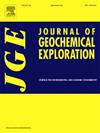Distribution and speciation of uranium in pristine Tethyan phosphorites, Ionian Zone, Albania: Insights from synchrotron XRF/XANES analyses
IF 3.3
2区 地球科学
Q1 GEOCHEMISTRY & GEOPHYSICS
引用次数: 0
Abstract
Tethyan phosphorites are globally the most important source of phosphate fertilizers and occasionally contain elevated contents of uranium (U) and rare-earth elements (REE). Extensive research has been conducted to elucidate Tethyan phosphorite occurrences, geochemistry, and formation mechanisms. However, the distribution and primary speciation of uranium in Tethyan phosphorites, during sedimentation and early diagenesis, remain unclear due to the scarcity of pristine phosphorites. This contribution integrates field and laboratory studies of Tethyan phosphorites of the Ionian Zone from Albania, including petrography, paragenetic relationships, chemical compositions, and bulk and microbeam synchrotron U L3-edge X-ray absorption near-edge structure (XANES) and microbeam synchrotron X-ray fluorescence (μsXRF) mapping. These data provide a molecular-level understanding of the distribution, speciation, and enrichment mechanisms of uranium in pristine (primary) phosphorites. The phosphorites in the Ionian Zone of Albania occur as stratiform beds reaching several meters thick, lateral extension of up to 200 m, and U concentrations of up to 210 ppm. The phosphorites show three stages of mineral assemblages: primary mineralization dominated by carbonate-rich fluorapatite, organic matter, and phosphatized thin bivalve shells; followed by vein-filling calcite and pyrite; and finally, pyrite oxidation to iron oxides during surface weathering. The μsXRF mapping reveals positive correlations between U vs. P, S, and Sr, while bulk and microbeam U L3-edge XANES data indicate dominant U4+ species in carbonate-rich fluorapatite. The results collectively suggest that uranium occurs as U4+ in pristine carbonate-rich fluorapatite, formed in a low-energy, oxygen-minimum marine environment. These findings not only enhance our understanding of the formation mechanisms of uranium-bearing Tethyan phosphorites but also provide a baseline for determining uranium enrichment mechanisms in marine phosphorites worldwide.

阿尔巴尼亚伊奥尼亚地区原始特提斯磷矿中铀的分布和形态:来自同步加速器XRF/XANES分析的见解
特提斯磷矿是全球磷肥最重要的来源,偶尔含有铀(U)和稀土元素(REE)的含量升高。已经进行了广泛的研究,以阐明特提斯磷矿的赋存、地球化学和形成机制。然而,由于原始磷岩的缺乏,在沉积和早期成岩作用期间,特提斯磷岩中铀的分布和原始形态尚不清楚。这一贡献整合了来自阿尔巴尼亚爱奥尼亚带的特提斯磷矿的野外和实验室研究,包括岩石学、共生关系、化学成分、体和微束同步加速器U l3边缘x射线吸收近边缘结构(XANES)和微束同步加速器x射线荧光(μsXRF)映射。这些数据提供了对原始(原生)磷岩中铀的分布、形态和富集机制的分子水平理解。阿尔巴尼亚爱奥尼亚带的磷质岩呈层状,厚度可达数米,横向延伸可达200米,铀浓度可达210 ppm。磷矿岩呈现出3个阶段的矿物组合:原生矿化以富碳酸盐氟磷灰石、有机质和磷化薄双壳为主;其次是充填静脉的方解石和黄铁矿;最后,黄铁矿在表面风化过程中氧化为氧化铁。μsXRF图谱显示U与P、S和Sr呈正相关,而体束和微束U l3边缘XANES数据显示富碳酸盐氟磷灰石中占优势的U4+物种。结果表明,铀以U4+的形式存在于原始的富含碳酸盐的氟磷灰石中,形成于低能、低氧的海洋环境中。这些发现不仅提高了我们对特提斯含铀磷岩形成机制的认识,而且为确定世界范围内海相磷岩的铀富集机制提供了基础。
本文章由计算机程序翻译,如有差异,请以英文原文为准。
求助全文
约1分钟内获得全文
求助全文
来源期刊

Journal of Geochemical Exploration
地学-地球化学与地球物理
CiteScore
7.40
自引率
7.70%
发文量
148
审稿时长
8.1 months
期刊介绍:
Journal of Geochemical Exploration is mostly dedicated to publication of original studies in exploration and environmental geochemistry and related topics.
Contributions considered of prevalent interest for the journal include researches based on the application of innovative methods to:
define the genesis and the evolution of mineral deposits including transfer of elements in large-scale mineralized areas.
analyze complex systems at the boundaries between bio-geochemistry, metal transport and mineral accumulation.
evaluate effects of historical mining activities on the surface environment.
trace pollutant sources and define their fate and transport models in the near-surface and surface environments involving solid, fluid and aerial matrices.
assess and quantify natural and technogenic radioactivity in the environment.
determine geochemical anomalies and set baseline reference values using compositional data analysis, multivariate statistics and geo-spatial analysis.
assess the impacts of anthropogenic contamination on ecosystems and human health at local and regional scale to prioritize and classify risks through deterministic and stochastic approaches.
Papers dedicated to the presentation of newly developed methods in analytical geochemistry to be applied in the field or in laboratory are also within the topics of interest for the journal.
 求助内容:
求助内容: 应助结果提醒方式:
应助结果提醒方式:


